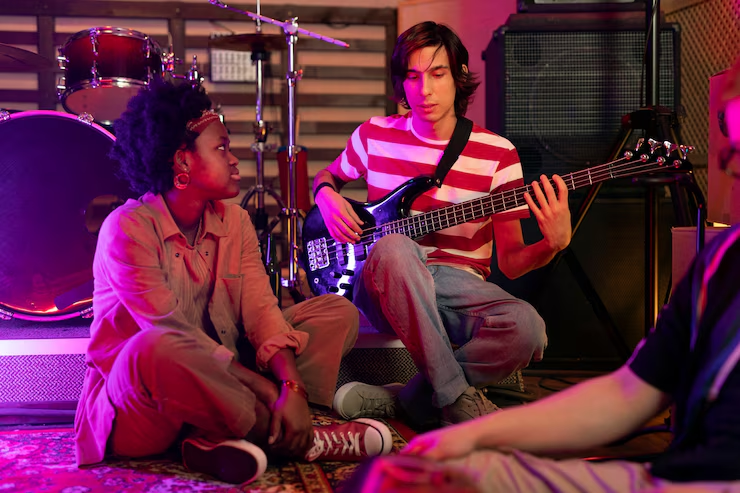1. Institutions as Cultural Bridges
Both Cairo and London have served as nurturing nodes in a transnational artistic network, closely coordinated through cultural institutions:
- The British Council’s cultural networks, especially its International Collaboration Grants and Cairo Calling project, formally link Egyptian and UK artists across music, visual art, film, and digital media. These initiatives fund residencies, workshops, and joint showcases in both capitals.
- London’s Delfina Foundation, a leading residency program originally focused on artists from the Middle East and North Africa, regularly hosts Egyptian creatives for extended stays—offering studio access, public programming, and connections into London’s galleries and curatorial scenes.
2. Music: Mahraganat Meets London Underground
Cairo Calling — Mahraganat x Electronic Collab
In 2014, Cairo Calling brought London-based electronic musicians (including Rinse FM artists) to Cairo and Egyptian artists—especially from 100 Copies label—to London. They exchanged studio sessions, performed at D‑CAF in Cairo, and collaborated on an album released via Rinse TV. This marked one of the first structured crossings between London bass scenes and Cairo’s electro‑shaʿbī underground.
Hossam Ramzy — Sultan of London Percussion
Percussion maestro Hossam Ramzy (Cairo‑born, later London‑based) curated the Egyptian string and percussion ensemble for Jimmy Page & Robert Plant’s No Quarter: Unledded tour and MTV special in 1994, introducing darbuka, doholla, bendir, and other Egyptian rhythms to Western rock audiences.
The Ayoub Sisters — Silk‑Celtic Strings Unite
Scottish‑Egyptian duo Sarah and Laura Ayoub—trained at Royal Conservatoire of Scotland and Royal College of Music—blend classical string forms with Arabic melody and mahraganat. Their 2016 debut at Royal Albert Hall, broadcast on Classic FM, led to a No. 1 album with Decca and recognition as iconoclastic boundary-crossers. They have since performed at the Cairo Opera, Collab with Classic FM, and toured in both Cairo and London.
3. Visual & Multimedia Storytelling
Hassan Khan — Urban Interventions in Motion
Berlin- and Cairo-based Hassan Khan, born in London in 1975, works with video, sound installation, and performance to deconstruct notions of public space and identity. Active across Cairo art festivals and London biennales, Khan’s practice is emblematic of a restless, boundary-transcending Egyptian–British sensibility.
Nermine Hammam — Revolutionary Layered Collage
Leveraging digital montage and color symbolism, Nermine Hammam juxtaposes imagery from Tahrir Square (2011 uprising) with dreamlike Japanese aesthetics. Her solo show Cairo Year One opened at London’s Mosaic Rooms (in collaboration with Rose Issa Projects), displaying layered prints that merge collective trauma with artistic metamorphosis. Her works are held by the Victoria & Albert Museum among others.
Wael Shawky & Adham Faramawy — From Puppetry to Performance
- Wael Shawky, whose Cabaret Crusades series dramatised histories of the Crusades with handcrafted marionettes, debuted in a major solo exhibition at London’s Serpentine Gallery (2013), which also developed from a Serpentine‑Delfina/Cairo residency.
- Adham Faramawy, an Egypt‑origin London-based artist, has presented video, installation, and live performance at Tate Modern, Tate Britain, **Guggenheim (NY)’, and others. Their 2024 lecture‑performance Daughters of the River (at Tate’s Starr Cinema) wove Nile–Thames histories into a queer and diasporic poetic map.
4. Film & Exhibition Platforms
Luxor — Journalism and Artistry Join Hands
British–Egyptian feature film Luxor (2020), directed by Zeina Durra and produced by Film Clinic in Cairo, maps a story of a British aid‑worker reconnecting with an Egyptian archaeologist. Filmed entirely in Egypt and financed partly through UK–Egypt production networks, Luxor played at Sundance and later digitally released in the UK and MENA region.
The Art of Disruption — Cairo Art in Mayfair
In May 2023, Art D’Égypte curated The Art of Disruption: Retrospect at the Egyptian Cultural and Educational Bureau in Mayfair, London, in partnership with Christie’s. The show featured installations from Egyptian and diaspora artists (including JR, SpY, Ahmed Farid) from previous Forever Is Now exhibitions at the pyramids—but reimagined for London’s contemporary art scene.
5. How It Happens: Exchanges & Infrastructure
- Exchange residencies such as British Council–supported stays at Delfina (London) and Serpentine’s Edgware Road Project entitle artists from Egypt and the UK to work abroad, network with curators, and co‑produce exhibitions. For example, Wael Shawky’s Serpentine solo followed his London residency.
- British Council’s Cairo office provides training, incubation, and micro‑grants to Egyptian arts collectives (e.g. 100 Copies), enabling cross-border functioning—like the Cairo Calling model.
6. Why Cairo & London Work So Well
| Cairo Strengths | London Strengths |
|---|---|
| Emerging experimental scenes (e.g. mahraganat, street festivals) | Global funding institutions, festivals, and art infrastructure |
| Young, agile artist collectives (e.g. Cairo Calling, ZULI crew) | Established residencies, galleries, and media platforms |
| Multi‑lingual, multi‑disciplinary creatives with diasporic connections | International credibility and distribution channels |
- In London, many artists with partial Egyptian heritage benefit directly from the UK’s artistic infrastructure, yet remain inspired by Cairo’s aesthetics and politics (e.g. Ayoub Sisters, Adham Faramawy, Hassan Khan).
- In Cairo, collectives like 100 Copies and Medrar use residencies (often funded or advised by British Council programmes) to support the next generation of cross‑continental collaborations.
7. Looking Ahead: Virtual Platforms, AI & New Hybrid Forms
- The afterglow of Cairo Calling workshops now lives online in mixtapes, livestreamed sets, and YouTube documentaries—reflecting a hybrid digital future for cultural exchange.
- Programs like the British Council’s Creative Commissions (e.g. COP-inspired commissions) increasingly link artists from Cairo and London through AI, ecology, and climate storytelling—pointing toward intersections between activism, urban futures, and creative coding.
Conclusion: Stories That Bind Cities
Cairo–London collaborations—and the institutions that make them possible—have built more than creative exchanges: they have built imagined worlds, new audiences, and cultural solidarities that transcend borders. From the thunderous beat of a drum to the wings of a puppet, the two cities speak. Together they forge art that is locally rooted and globally connected.
As of August 2025, this network of Cairo–London artistic exchange continues thriving—manifested in poetry readings, residencies, exhibitions, and digital performances. Whether through Cairo‑born London-based artists or London artists drawn to Cairo, the bridge between these capitals remains vibrant, urgent, and full of possibility.

